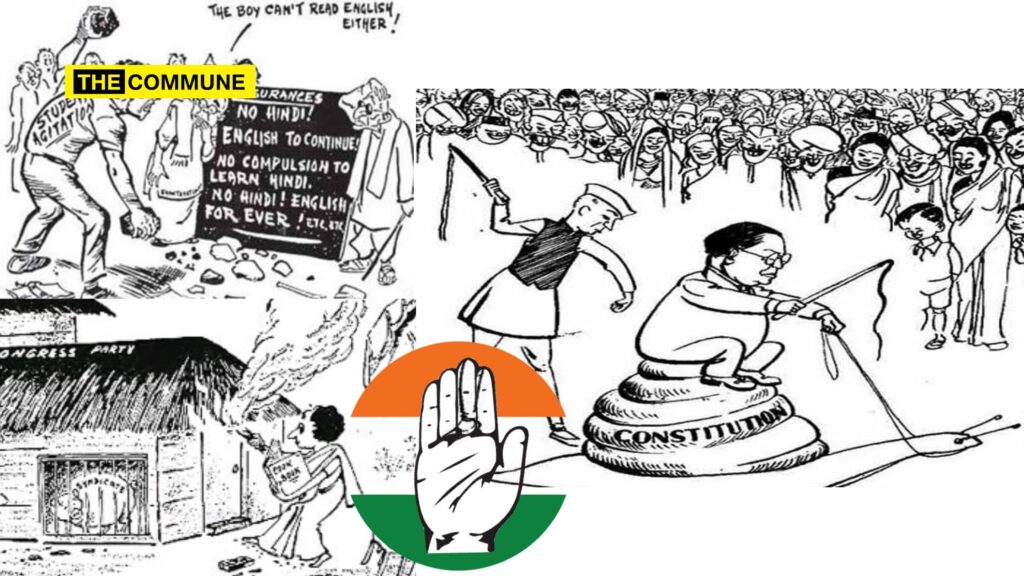In 2012, the National Council of Educational Research and Training (NCERT) removed six cartoons from its political science textbooks after a four-month-long controversy that rocked Parliament. The decision, approved by the National Monitoring Committee, came amidst debates on freedom of expression, classroom appropriateness, and parliamentary oversight. Let’s take a look at each one of them.
The Controversial Ambedkar Cartoon
Original Content: This cartoon depicted Dr. B.R. Ambedkar seated on a snail, symbolizing the slow pace of drafting the Indian Constitution, with Jawaharlal Nehru holding a whip, seemingly urging the process forward.
Context: Created during the 1950s, the cartoon highlighted frustrations with the lengthy Constitution-making process, which took nearly three years.
Controversy: Critics argued that this cartoon undermined the dignity of Dr. Ambedkar, who chaired the drafting committee and was a key architect of the Constitution. It was also perceived as trivializing the significant work of the Constituent Assembly.
Replacement: A photograph of Dr. Rajendra Prasad greeting Dr. Ambedkar, along with an excerpt from Prasad’s speech in the Constituent Assembly on November 26, 1949, was added to honor their roles.
Booth-Capturing Cartoon
Original Content: This illustration depicted a corrupt politician as a dark-skinned man involved in booth capturing, a common electoral malpractice during India’s early democratic years.
Context: The cartoon was intended to provoke discussions on electoral corruption and the challenges of ensuring free and fair elections in India.
Controversy: The depiction of the corrupt politician as dark-skinned was criticized for reinforcing racial and caste-based stereotypes, making it inappropriate for educational settings.
Replacement: The cartoon was replaced with a blank activity box, leaving room for classroom discussions without potentially offensive imagery.
Cartoon on Political Defection
Original Content: This cartoon illustrated the issue of political defection, where politicians switched parties, often for monetary or personal gain, undermining political stability.
Context: Political defection was a major problem in Indian politics, leading to the introduction of the Anti-Defection Law in 1985. The cartoon served as a visual critique of such practices.
Controversy: The cartoon was criticized for oversimplifying a complex issue and for potentially influencing students’ perceptions of political leaders.
Replacement: It was substituted with a text-based commentary on the role of money in politics, providing a more neutral way to address the issue.
R.K. Laxman’s Anti-Hindi Agitation Cartoon
Original Content: A cartoon by renowned illustrator R.K. Laxman depicted protests during the anti-Hindi agitation in Tamil Nadu, where opposition to the imposition of Hindi as the national language led to widespread unrest.
Context: The cartoon represented linguistic diversity and the tensions surrounding language policy in post-independence India.
Controversy: Critics argued that the cartoon could revive old linguistic divides and was insensitive to the cultural sentiments of Tamil-speaking communities.
Replacement: The cartoon was removed, and an accompanying photograph related to the historical context was enlarged for better emphasis.
Indira Gandhi and the ‘Pig in the Hut‘ Cartoon
Original Content: This cartoon depicted Indira Gandhi setting fire to a hut with a pig trapped inside. The hut symbolized the Congress party, and the pig represented the internal party syndicate.
Context: The cartoon referenced the political turmoil and internal conflicts within the Congress party during Indira Gandhi’s tenure as Prime Minister.
Controversy: The imagery of a pig, considered offensive in many cultural contexts, along with the depiction of internal political strife, was deemed inappropriate for a classroom setting.
Replacement: The cartoon was removed entirely.
Cartoon of Sheikh Abdullah Crowned by Indira Gandhi
Original Content: This cartoon showed Sheikh Abdullah, the prominent Kashmiri leader, being crowned by Indira Gandhi.
Context: The cartoon symbolized the political alliance and subsequent tensions between Sheikh Abdullah and the Congress government under Indira Gandhi.
Controversy: The cartoon was interpreted as showing favoritism or political manipulation by Indira Gandhi, which some felt was unsuitable for inclusion in a textbook.
Replacement: The cartoon was replaced with other content that maintained historical relevance without controversial depictions.
The Thorat Committee had suggested the removal of 22 cartoons from NCERT textbooks. Six had been dropped in 2012 and many were under review. While the Congress was happily disrespecting Ambedkar, they did not want the truth about the Congress party itself to be seen as a part of the curriculum.
(With inputs from India Today)
Subscribe to our channels on Telegram, WhatsApp, and Instagram and get the best stories of the day delivered to you personally.

